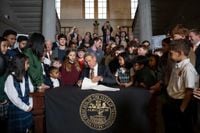Nia Smith remembers the moment she realized her son’s needs were not being met in his local public school. Like many parents of children with special needs, she wanted a learning environment that was both intimate and attentive—something that felt out of reach on her family’s budget. Then came the Opportunity Scholarship, North Carolina’s state school voucher, which allowed her to enroll her son at ALC Mosaic, a secular private school in east Charlotte. “It’s definitely worth it because it gives you so many other options,” Smith told The Charlotte Observer. “Being able to talk to the directors and speak with them directly and being in the know.”
Smith’s story is emblematic of a growing movement across the United States: families searching for alternatives to public education, aided by rapidly expanding voucher programs. North Carolina first introduced public funding for private school tuition in 2014, but only for families below a certain income threshold. That changed in the 2024-25 school year, when the state lifted income caps, opening the Opportunity Scholarship to families of all financial backgrounds. The result? Participation more than doubled in a single year. According to state data, more than 80,000 students received Opportunity Scholarships in 2024-25, with 42% coming from families earning over $115,000 annually—a group previously ineligible for assistance.
Mecklenburg County, home to Charlotte, saw a particularly dramatic shift. Of local voucher recipients in 2024-25, 58% came from households making more than $115,000, and 28% from those earning over $259,700. The county received $39 million in vouchers, nearly triple the amount from the previous year. Yet, the scholarship amounts—ranging from $7,468 for the lowest-income families to $3,360 for the wealthiest—often fall short of private school tuition. For example, Covenant Day School in Matthews charges between $14,290 and $21,590 per year, while Charlotte Christian School’s tuition ranges from $18,850 for pre-K to $24,605 for high school. Still, both schools saw a windfall from the program, with Covenant Day receiving $3.3 million in Opportunity Scholarships and Charlotte Christian $2.4 million—sums that dwarfed their previous year’s allocations.
North Carolina’s embrace of universal vouchers mirrors a nationwide trend. As PBS NewsHour reported, two-thirds of America’s public schools have lost students in recent years, a decline fueled partly by demographic shifts but also by the proliferation of school choice policies. Arizona, often cited as the national model, now offers families up to $7,500 per child through its voucher program. “There is really a philosophy underlying all of this, which is that schools should be subject to the same sort of marketplace forces that are at work when we’re choosing other things that are important in our lives and that public schools should not have a monopoly on public funds or on students,” Laura Meckler, a national education reporter for The Washington Post, told PBS NewsHour.
But the expansion comes with fierce debate. Proponents argue that vouchers empower parents, especially those with children whose needs aren’t met in public schools. Tomis Parker, Director of Operations at ALC Mosaic, underscores the value of making education accessible. “We have always made an effort to be as financially accessible as possible,” Parker told The Charlotte Observer. “We believe that education should be a public good and accessible to people.” His school uses a sliding scale tuition model, with some families paying as little as $800 a year. Yet, Parker acknowledges that for most private schools, even the largest vouchers are just “a drop in the bucket.”
Critics, meanwhile, warn that vouchers siphon resources from already underfunded public schools. “The reality is that vouchers are taking away resources needed to serve our students with disabilities, for example. Public schools are serving the majority of children, and if we’re not fully funding them, higher income people can afford higher cost options while others can’t,” said Elizabeth Paul, policy and research manager at NC Public School Forum, in The Charlotte Observer. She added, “You cannot say something is failing if you’ve never given it the chance to succeed.”
The numbers are telling. Of the 53,000 new voucher recipients in North Carolina last year, about 87% were already enrolled in private schools. That means the program is often subsidizing families who had already opted out of the public system, rather than enabling new access for low-income students. This pattern echoes what’s happening in Arizona and other states, as highlighted by PBS NewsHour: many voucher recipients were never in public schools to begin with, turning the program into a new expense for the state rather than a transfer of students from one system to another.
The demographic impact is also significant. In North Carolina, white students are overrepresented in private schools—74% of private school students were white in 2021-22, compared to just 45% of public school students, according to ProPublica data cited by The Charlotte Observer. After voucher expansion, white students made up 73% of new voucher recipients, a 10-point jump from the previous year. Meanwhile, Black and Hispanic students’ shares fell by 8 and 5 points, respectively. Researchers warn that this trend could exacerbate school segregation, which has been on the rise in North Carolina for three decades. “I would expect that it would increase the amount of people going to private schools and, according to what we’ve found, that will increase segregation,” said Charles Clotfelter, a former Duke University professor who has studied the economics of education.
Despite these shifts, the overall enrollment and demographic makeup of Charlotte-Mecklenburg Schools (CMS) remained virtually unchanged in 2024-25. Across North Carolina, public school enrollment held steady at about 1.5 million students. However, the drain on resources is real: the 5,955 students who moved from public to private schools in 2024 accounted for $34.4 million in voucher funds, about 18.5% of the total $185.6 million awarded that year. If those students had remained in public schools, the state would have spent $44.5 million in district funding; officials say the $10.1 million difference will be reinvested in public education.
Public schools are not standing still. As PBS NewsHour noted, districts are ramping up efforts to recruit families and highlight their strengths, especially for students with special needs—who, by law, must be served by public schools. Still, the competitive pressure is intense. “The only solution to this problem is for educational dollars to follow the child, not the system, which alone provides families everything they need to get the best education for their children,” said Mike Long, president of Parents for Education Freedom in North Carolina.
Amid these battles, the future of American education hangs in the balance. With a new federal tax credit set to take effect in 2027, which will allow states to offer a 100% tax credit for donations to scholarship organizations, the reach of vouchers may soon extend even further. For now, the debate continues: Are vouchers a lifeline for families like Nia Smith’s, or a drain on public schools and a driver of deeper segregation? One thing is certain—how states answer that question will shape the nation’s classrooms for years to come.




